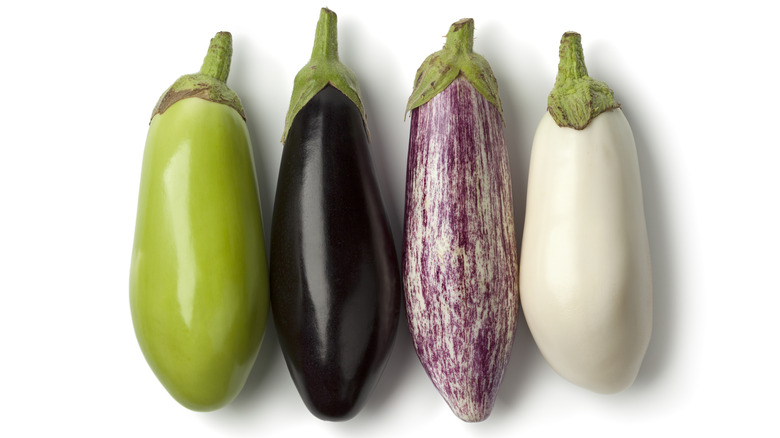How To Find The Good Eggplants At The Grocery Store
Eggplants aren't exactly America's favorite fruit (yes, they're technically fruits), so if they're not in your regular dinner rotation, it can be hard to find the best eggplants at the store. And some advice is counterintuitive: Unlike many fruits and veggies, large, mature eggplants taste bitter, not sweet. Other tips are more standard. For example, you can follow the "heavy-for-its-size" rule for the most flavorful fruit.
For many varieties, you'll want to look for a vibrant, even color — though some cultivars have a naturally mottled look. The skin should always be taught and shiny, free of wrinkles, bruises, or scars. Don't forget to check the stem, too. Brown, mushy stems are a bad sign, even if the rest of the eggplant passes the test.
Once you've found an eggplant, pick it up and give it a few gentile pokes. Eggplants should feel firm, but not hard. If it feels like poking a watermelon rind, skip it: It's underripe. But eggplants shouldn't feel too soft, either. By the time the skin feels slightly squishy, like a ripe tomato or peach, it's too far gone.
It's helpful to know your varieties, too. Any eggplant will taste bitter if it's left on the vine too long, but some varieties have a milder taste than others. Eggplants aren't one-size-fits-all when it comes to cooking methods, either. Some smaller varieties can be delicate, so they might turn to mush in curries or stews. Grill or roast them instead. And always remember to store your eggplants properly and eat them quickly: Eggplants don't last.
Some common eggplant varieties
In the United States, globe eggplants — also called American eggplants — are your standard grocery store staple. They're big, fat, glossy, and dark purple. Since globe eggplants have tough skins, you'll want to peel them for most dishes. Italian eggplants are smaller and sweeter, with tender flesh, but otherwise they look and feel similar to their American cousins.
Adorably-named, thumb-sized fairy tale eggplants are mottled purple and white. To cook them, simply slice them in half lengthwise — or even roast them whole. Asian varieties, like Japanese and Chinese eggplants, are long and thin with delicate skins and a mild flavor. They won't work well for many Western eggplant dishes, but Asian eggplants taste sublime fried and marinated in Nuoc Cham.
In some farmer's markets or specialty grocers you might even find varieties that look nothing like your mental image of an eggplant. Some are white, yellow, or orange. Others are green, like the small, squat Thai eggplant variety. Thai eggplants have a sharp, sour, and slightly herbal taste. Most red and orange varieties, like orange-and-green tiger-striped toga eggplants, fall on the bitter side. Still, toga eggplants are a staple in many African countries, where they're used in stews or eaten raw.
Be warned: Different varieties of eggplants might not taste like what you're used to. If you have a specific flavor in mind, do a little research before buying something new. But don't be afraid to experiment, either. You might find a new favorite food.

